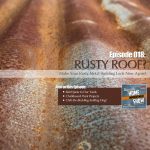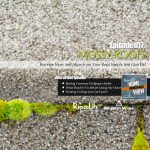Our ceilings are often like that one guy in the office. The quiet one who everyone forgets to invite to the party. Don’t let that happen in your home! Sure, your walls are having fun trying on new colors and looking good, but don’t leave your ceilings out! In this episode, we talk with Designer Kim Scott to talk about ceilings and some interesting ways to use them to make a statement!
Listen here:
Show notes for episode 020:
Many of us hate vacuuming. Especially if we have stairs! Just the thought of lugging that heavy, awkward vacuum up and down the stairs makes us groan. But we have a solution!
Tom Courtright from WalVac stops by to tell us about his amazing central vacuum system that will save our backs the next time we vacuum stairs. We've heard from many people who have this system, and they say they'll never go back to a regular vacuum. We think that speaks for itself!
When we ask customers if they are going to paint their ceilings, we often get a blank stare. It just seems like one more thing to do. But it's time to change your thinking! Your ceiling deserves just as much attention as your walls.
Kim Scott, of KJS Interiors, is an interior designer who loves to use color in her decorating. She gives us tips on how to use color on ceilings to create that "wow" factor!
No one likes to make multiple trips to the paint store for a color match. We want to help you make one trip by telling you everything we need to get your match done right the first time.

Shopping for a new house can be very overwhelming. There is so much to look at and consider. It is very easy to miss or overlook important things.
To help us know what to pay attention to, Rodger Nyhuis, of Keller Williams Holland Lakeshore Realty, stops by to discuss what he tells his clients. He has great information that will help us be more thorough the next time we walk through a house.











 The first thing we tested was a right angle attachment. It's great for tight spots where you would normally have to angle the drill and still not have a straight shot at drilling a hole or tightening a screw. It's made for an impact driver, but can be used with a regular drill.
The first thing we tested was a right angle attachment. It's great for tight spots where you would normally have to angle the drill and still not have a straight shot at drilling a hole or tightening a screw. It's made for an impact driver, but can be used with a regular drill. These drywall screw setters are great for setting drywall screws to just the perfect depth. You don't have to worry about a giant crater in the drywall or going through the paper. They help you achieve professional looking results every time.
These drywall screw setters are great for setting drywall screws to just the perfect depth. You don't have to worry about a giant crater in the drywall or going through the paper. They help you achieve professional looking results every time.
 This drill and driver combo is a huge time saver! Many people alternate between a drilling holes and driving screws. They take one tool out, set it aside, and replace it with a new one. This often leads to missing tools. This eliminates that. Basically, it’s a bit that has a drill bit on one end and a driver bit on the other that you flip , depending on your task. It saves a lot of time searching for missing drill bit!
This drill and driver combo is a huge time saver! Many people alternate between a drilling holes and driving screws. They take one tool out, set it aside, and replace it with a new one. This often leads to missing tools. This eliminates that. Basically, it’s a bit that has a drill bit on one end and a driver bit on the other that you flip , depending on your task. It saves a lot of time searching for missing drill bit!
 These are Betsy's favorite drill accessory! No tool box should be without a set of easy outs. They make fast work of removing screws the have stripped heads. Betsy tried the "rubber band trick" and it didn't work, so she has been a fan of these every since.
These are Betsy's favorite drill accessory! No tool box should be without a set of easy outs. They make fast work of removing screws the have stripped heads. Betsy tried the "rubber band trick" and it didn't work, so she has been a fan of these every since.
 We are aware that keyless chucks have made accessory changing a lot faster than keyed chucks. But we have found the even faster way. This quick change adapter will have you changing out tools in a flash.
And finally, we tried out the new Hyde Stir Whip. It made quick work of mixing paint, and the fact that it can mix grout and concrete as well, makes it a must have accessory in our book!
Watch the Hyde Stir Whip in action!
We are aware that keyless chucks have made accessory changing a lot faster than keyed chucks. But we have found the even faster way. This quick change adapter will have you changing out tools in a flash.
And finally, we tried out the new Hyde Stir Whip. It made quick work of mixing paint, and the fact that it can mix grout and concrete as well, makes it a must have accessory in our book!
Watch the Hyde Stir Whip in action!

 Green lawns are something we all strive for. A sprinkler system may help. But for those with an older system, it can be very complicated.
Aaron Katerberg from Grapids Irrigation joins us in the studio once again. This time he tells us all about the newest technology in sprinkler systems. The best news is, many things can be retrofitted to older systems.
Green lawns are something we all strive for. A sprinkler system may help. But for those with an older system, it can be very complicated.
Aaron Katerberg from Grapids Irrigation joins us in the studio once again. This time he tells us all about the newest technology in sprinkler systems. The best news is, many things can be retrofitted to older systems.